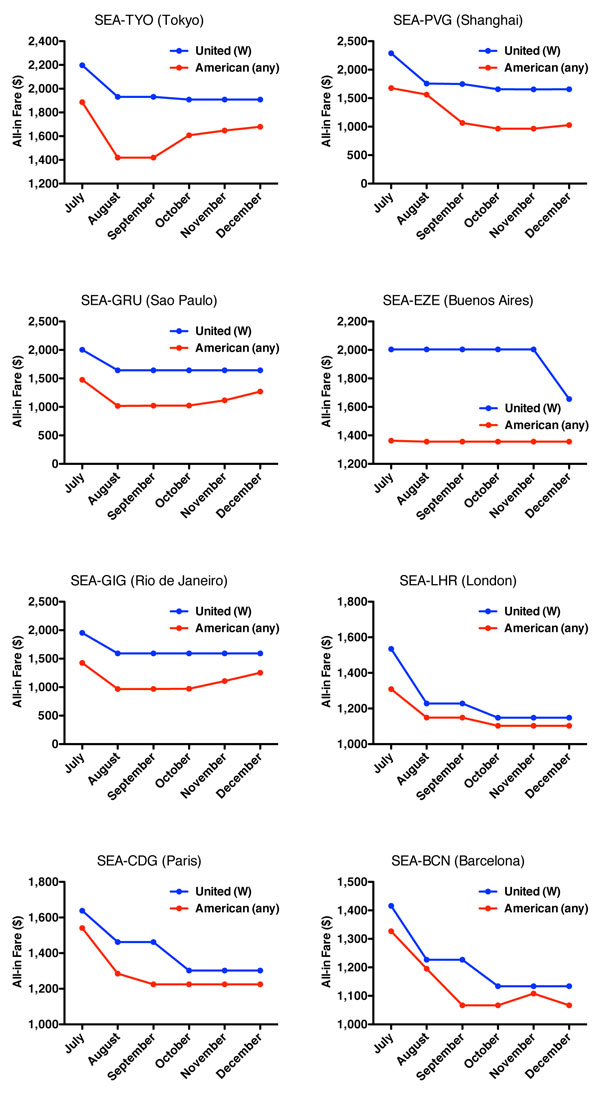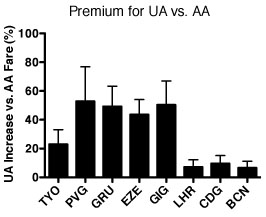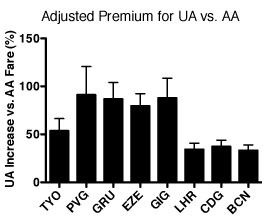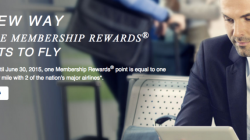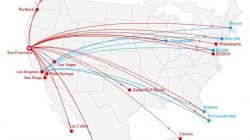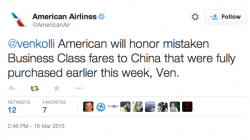A few days ago I provided a comparison of United’s Premier 1K status and American’s Executive Platinum status. One of the benefits of top-tier status with an airline is usually systemwide upgrade certificates, and a reader asked if I could compare the actual cost of purchasing an upgradedable fare on United vs. American. I hope these results will be useful not just for comparing the cost of upgradeable fares but also for looking at the cheapest destination for your next international vacation or mileage run.
I earned 1K fair and square, flying just over 100,000 miles in 2011, but American recently gave me a free match to Executive Platinum that came with the systemwide upgrades even though I haven’t flown a single mile with them in several years. I knew that upgrades were generally cheaper and easier to use with American, but I didn’t know just how much, and I figured this was the kind of analysis that would help not just my readers but also me as I consider if I should switch my allegiance. I was still leaning toward United before, but now I am strongly considering American–at least for international travel.
As usual, I try to limit the fares I post to those originating in the Pacific Northwest. A lot of bloggers and readers on BoardingArea are in the New York or DC areas, and I think it’s nice to remind people that there is another Washington out there. 😉 I also think it provides better information for the large majority of the country that does not have three major airports serving a single metropolitan area. Neither Seattle, Portland, nor Vancouver are hubs for American or United; I’ve only done Seattle for now, but I will try to do similar comparisons for Portland and Vancouver. Please provide feedback before then if you’d like me to change my methods.
Systemwide Upgrade Rules
United Premier 1Ks receive six (6) Global Premier Upgrades each year. They must be used on W fares or higher (mid-priced economy class) on United-operated flights. They can also be used on Lufthansa-operated flights, but I’ve excluded that option from my analysis for convenience. American Executive Platinums receive eight (8) eVIP upgrades each year. They can be used on any fare on American-operated flights. To search for United-operated flights, I used the following ITA search command, which limits results to United-operated flights with any number of connections booked in the W fare class:
SEA :: O:UA+ /f bc=w
To search for American-operated flights, I used a slightly simpler command:
SEA :: O:AA+
Destination, Routing, and Mileage Considerations
Obviously United and American have very different route networks, and the limitations of American’s network are one of the reasons they are currently in bankruptcy protection. I limited my search to destinations served by both carriers even though some, like United’s service to Hong Kong, are among those more reasonably priced (but not served by American). Also, some fares may be comparable on both airlines, but American requires a routing that provides many more miles, which could make it less convenient or a better mileage-run opportunity depending on your perspective. For example, a flight on United to Tokyo might connect in San Francisco, while American will require you to connect in Dallas-Fort Worth. For the sake of time and convenience, I ignored routing and mileage.
Data Collection
This process was very simple if time-consuming. I used ITA to search for a trip of 5 to 7 nights from Seattle to a given international destination during the 30-day period starting on the first of the month. I then looked for the cheapest fare during that month, from July through December. I stopped there since fares usually changed less after October.
These are all-in fares that include taxes and other fees. Note that some destinations will require you to get a visa, which I did not include in my calculations. I compared two destinations in Asia (where American serves few markets), three in South America, and three in Europe.
Comparison of Upgradeable Fares between United and American
As you can see in the charts below, United always has higher prices. This makes perfect sense if you consider that American will let you upgrade even the cheapest fare while United requires at least a mid-priced ticket. If anything, it’s surprising that sometimes the difference is only about $100, but at other times the difference is over $500.
Average Fare Premium for United Varies from 10% to 100%
This analysis was intended to address an important question: I know that American should have an advantage because I can upgrade the cheapest economy class ticket, but just how much cheaper is it compared to United? In the chart below, I’ve averaged the premium for an upgradeable United ticket over the cheapest American ticket over the six-month period shown above. Error bars are +/- one standard deviation.
As you can see, the lowest premium is for European destinations. Maybe this is because it’s such a competitive market where both airlines have a big presence. If anything, I’m surprised the difference is only 10% more for United’s higher W-class fares. By contrast, several upgradeable fares, including all those to South America, are on average 50% more when traveling on United.
Don’t Forget You Can Easily Save More Money with American
At the end of my post on Friday, I briefly mentioned that you can easily save 20-30% on most American Airlines tickets by purchasing a pre-paid AmEx with an Ink Bold business card, using it to purchase American giftcards at Costco at another 10% discount, and then adding on various 5-10% discount codes when available. There is little excuse for anyone to be paying full price on American Airlines; at a minimum you should save 10% through Costco giftcards alone. I reworked the figure above assuming the prices for American tickets were purchased at a 20% discount to the advertised price.
This time, the differences were much more striking. Those 50% premiums for South America became almost 100%, and the 10% premiums for Europe became 30%. Clearly you can save hundreds or even thousands of dollars on upgradeable fares with American over the course of a year. And you get two extra upgrade certificates, too! Is there anything else I should consider before repeating this with Portland and Vancouver? I’m especially interested in what I’ll find with the latter since prices out of Canada can sometimes be so much higher or even lower.


